Auditing Assignment: Internal Control Analysis of Two Companies
VerifiedAdded on 2020/03/28
|13
|3042
|239
Report
AI Summary
This report presents an analysis of internal controls within two companies, Acid Pty Ltd and Cannon Pty Ltd. The Acid Pty Ltd case study focuses on the sales order and delivery systems, evaluating strengths such as the structured order processing and segregation of duties, and weaknesses including the acceptance of orders via various non-formal channels and issues with handling rejected orders and stock alterations. The Cannon Pty Ltd case study examines the cash collection system, highlighting strengths like the crossing of cheques and aging of receipts, but also weaknesses in the concentration of duties in a single individual and potential reconciliation issues. The report assesses the implications of these weaknesses, including potential fraud, revenue loss, and inaccurate financial reporting, and proposes recommendations to improve internal controls, mitigate risks, and enhance operational efficiency. Control risk assessments are provided for both companies, emphasizing the need for enhanced documentation, segregation of duties, and improved reconciliation processes to ensure financial accuracy and prevent potential misstatements.

AUDITING ASSIGNMENT
Paraphrase This Document
Need a fresh take? Get an instant paraphrase of this document with our AI Paraphraser
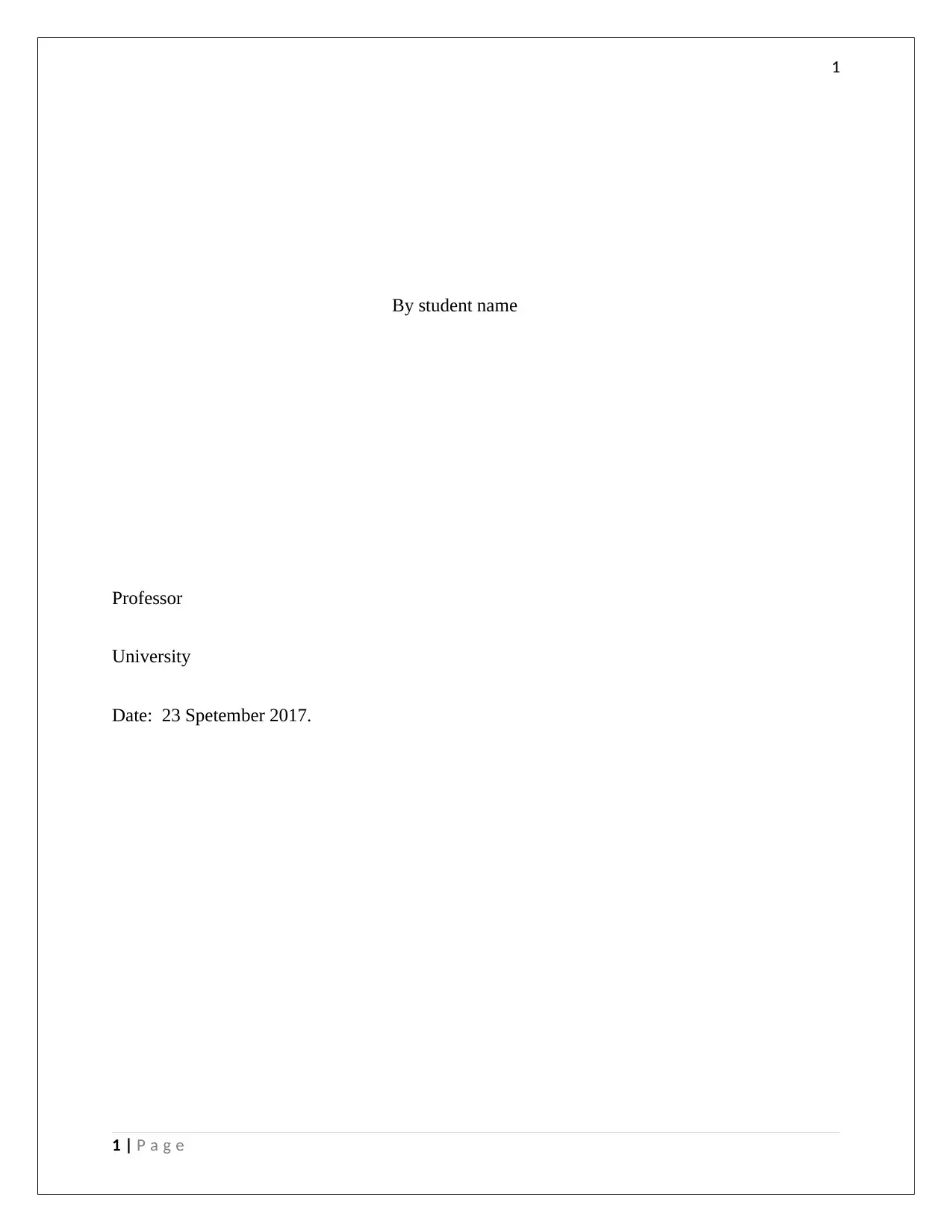
1
By student name
Professor
University
Date: 23 Spetember 2017.
1 | P a g e
By student name
Professor
University
Date: 23 Spetember 2017.
1 | P a g e
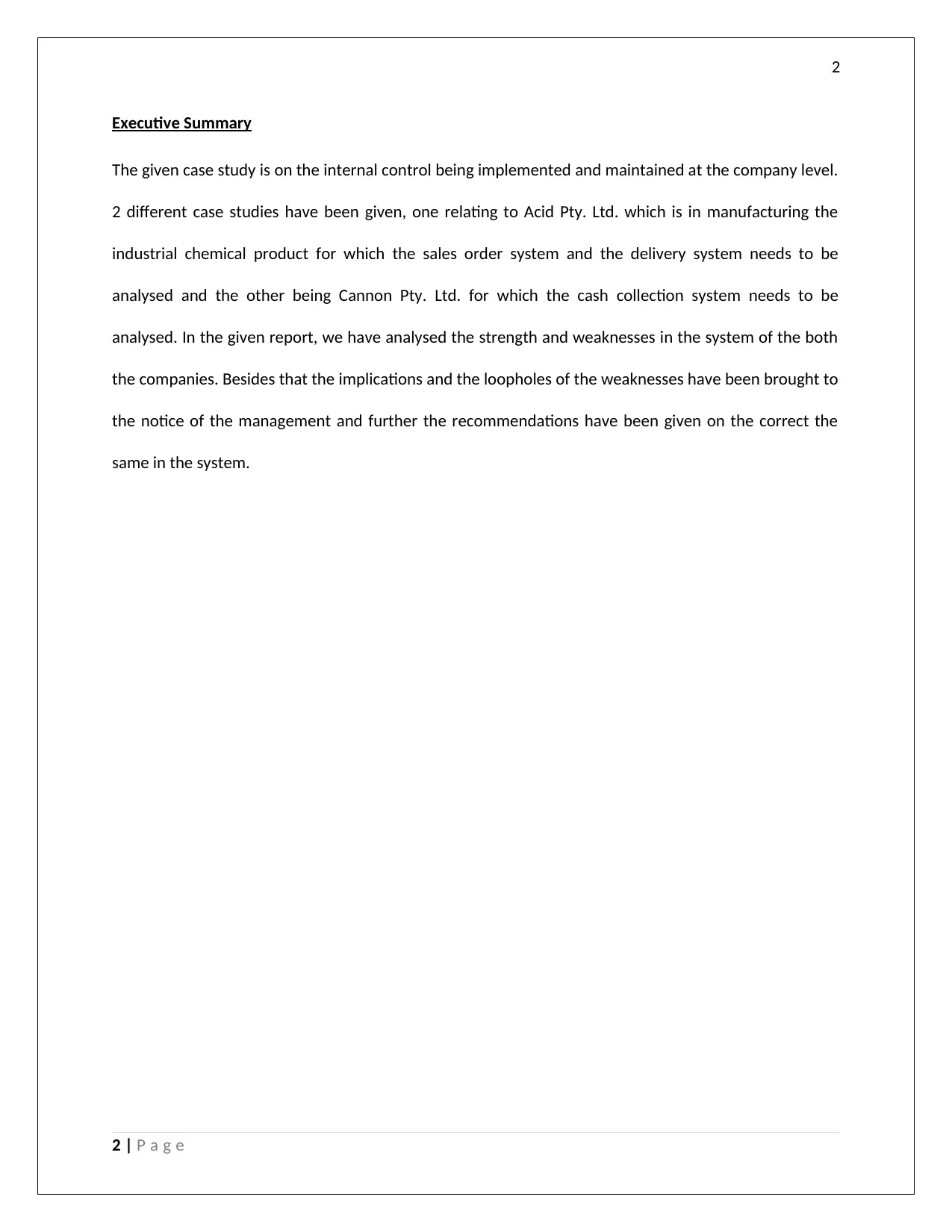
2
Executive Summary
The given case study is on the internal control being implemented and maintained at the company level.
2 different case studies have been given, one relating to Acid Pty. Ltd. which is in manufacturing the
industrial chemical product for which the sales order system and the delivery system needs to be
analysed and the other being Cannon Pty. Ltd. for which the cash collection system needs to be
analysed. In the given report, we have analysed the strength and weaknesses in the system of the both
the companies. Besides that the implications and the loopholes of the weaknesses have been brought to
the notice of the management and further the recommendations have been given on the correct the
same in the system.
2 | P a g e
Executive Summary
The given case study is on the internal control being implemented and maintained at the company level.
2 different case studies have been given, one relating to Acid Pty. Ltd. which is in manufacturing the
industrial chemical product for which the sales order system and the delivery system needs to be
analysed and the other being Cannon Pty. Ltd. for which the cash collection system needs to be
analysed. In the given report, we have analysed the strength and weaknesses in the system of the both
the companies. Besides that the implications and the loopholes of the weaknesses have been brought to
the notice of the management and further the recommendations have been given on the correct the
same in the system.
2 | P a g e
⊘ This is a preview!⊘
Do you want full access?
Subscribe today to unlock all pages.

Trusted by 1+ million students worldwide
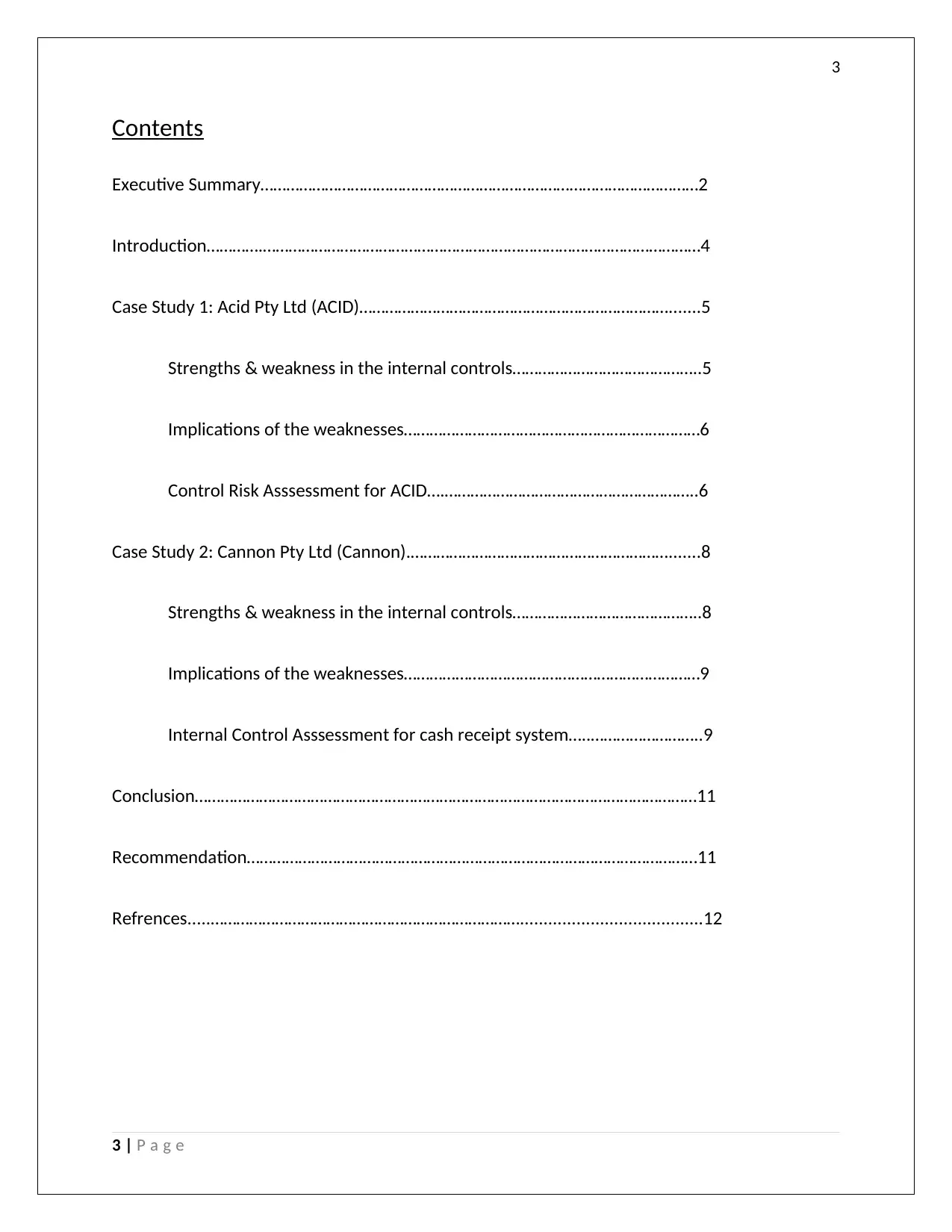
3
Contents
Executive Summary…………………………………………………………………………………………2
Introduction………….…………………………………………………………………………………………4
Case Study 1: Acid Pty Ltd (ACID)……………………………………………………………….......5
Strengths & weakness in the internal controls……………………………………..5
Implications of the weaknesses……………………………………………………………6
Control Risk Asssessment for ACID….…………………………………………………..6
Case Study 2: Cannon Pty Ltd (Cannon).…………………………………………………….......8
Strengths & weakness in the internal controls……………………………………..8
Implications of the weaknesses……………………………………………………………9
Internal Control Asssessment for cash receipt system…..……………………..9
Conclusion………………………………………………………………………………………………………11
Recommendation……………………………………………………………………………………………11
Refrences.....……………………………………………………………….......................................12
3 | P a g e
Contents
Executive Summary…………………………………………………………………………………………2
Introduction………….…………………………………………………………………………………………4
Case Study 1: Acid Pty Ltd (ACID)……………………………………………………………….......5
Strengths & weakness in the internal controls……………………………………..5
Implications of the weaknesses……………………………………………………………6
Control Risk Asssessment for ACID….…………………………………………………..6
Case Study 2: Cannon Pty Ltd (Cannon).…………………………………………………….......8
Strengths & weakness in the internal controls……………………………………..8
Implications of the weaknesses……………………………………………………………9
Internal Control Asssessment for cash receipt system…..……………………..9
Conclusion………………………………………………………………………………………………………11
Recommendation……………………………………………………………………………………………11
Refrences.....……………………………………………………………….......................................12
3 | P a g e
Paraphrase This Document
Need a fresh take? Get an instant paraphrase of this document with our AI Paraphraser
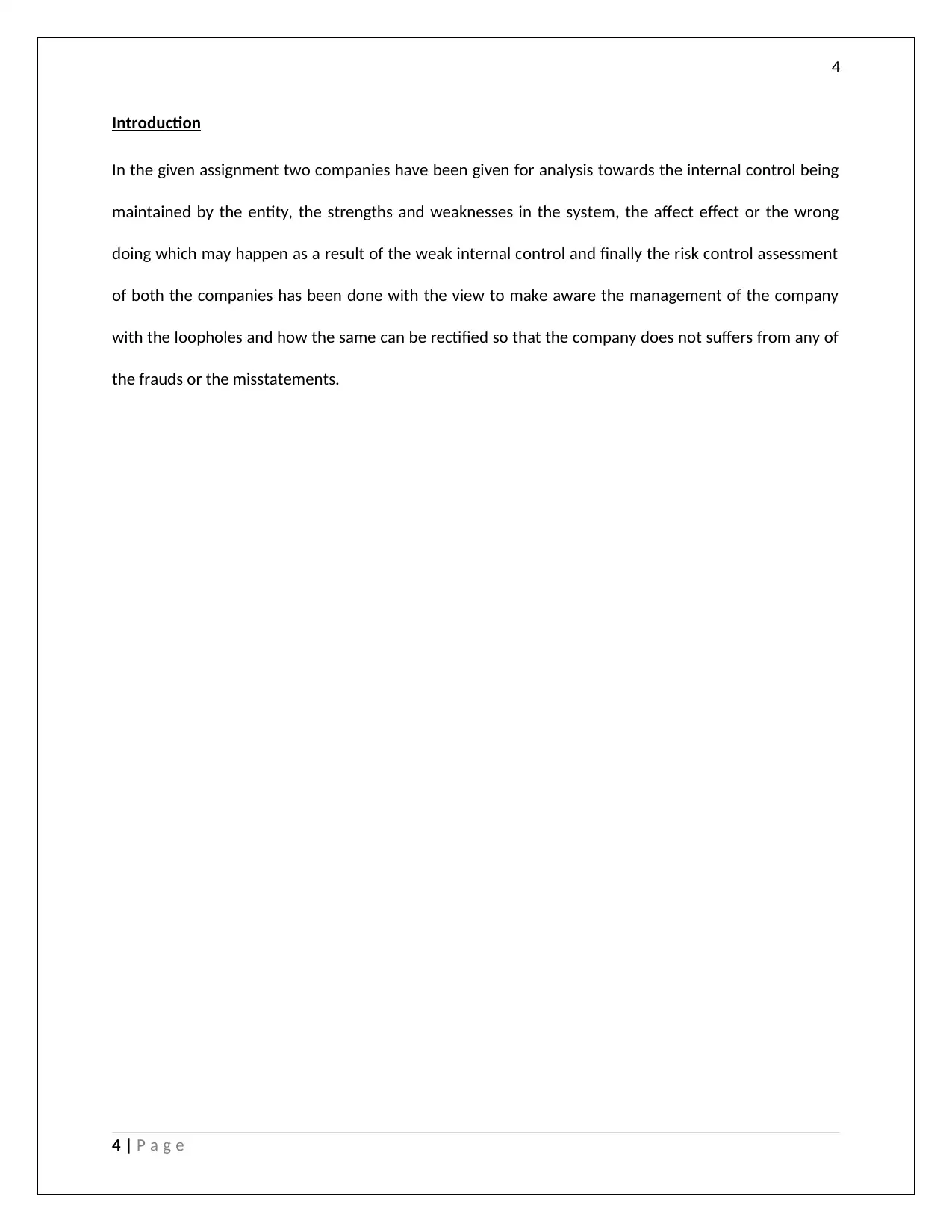
4
Introduction
In the given assignment two companies have been given for analysis towards the internal control being
maintained by the entity, the strengths and weaknesses in the system, the affect effect or the wrong
doing which may happen as a result of the weak internal control and finally the risk control assessment
of both the companies has been done with the view to make aware the management of the company
with the loopholes and how the same can be rectified so that the company does not suffers from any of
the frauds or the misstatements.
4 | P a g e
Introduction
In the given assignment two companies have been given for analysis towards the internal control being
maintained by the entity, the strengths and weaknesses in the system, the affect effect or the wrong
doing which may happen as a result of the weak internal control and finally the risk control assessment
of both the companies has been done with the view to make aware the management of the company
with the loopholes and how the same can be rectified so that the company does not suffers from any of
the frauds or the misstatements.
4 | P a g e
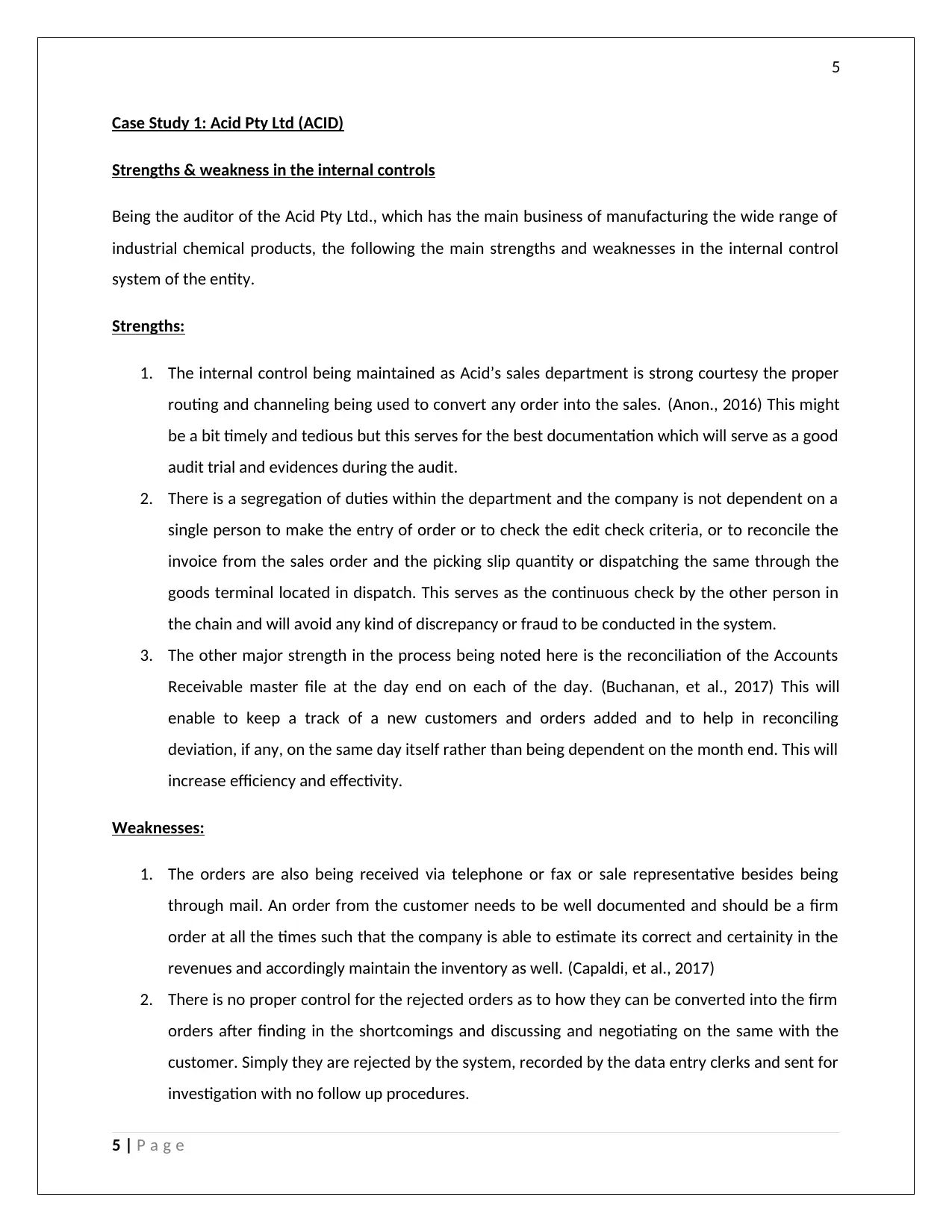
5
Case Study 1: Acid Pty Ltd (ACID)
Strengths & weakness in the internal controls
Being the auditor of the Acid Pty Ltd., which has the main business of manufacturing the wide range of
industrial chemical products, the following the main strengths and weaknesses in the internal control
system of the entity.
Strengths:
1. The internal control being maintained as Acid’s sales department is strong courtesy the proper
routing and channeling being used to convert any order into the sales. (Anon., 2016) This might
be a bit timely and tedious but this serves for the best documentation which will serve as a good
audit trial and evidences during the audit.
2. There is a segregation of duties within the department and the company is not dependent on a
single person to make the entry of order or to check the edit check criteria, or to reconcile the
invoice from the sales order and the picking slip quantity or dispatching the same through the
goods terminal located in dispatch. This serves as the continuous check by the other person in
the chain and will avoid any kind of discrepancy or fraud to be conducted in the system.
3. The other major strength in the process being noted here is the reconciliation of the Accounts
Receivable master file at the day end on each of the day. (Buchanan, et al., 2017) This will
enable to keep a track of a new customers and orders added and to help in reconciling
deviation, if any, on the same day itself rather than being dependent on the month end. This will
increase efficiency and effectivity.
Weaknesses:
1. The orders are also being received via telephone or fax or sale representative besides being
through mail. An order from the customer needs to be well documented and should be a firm
order at all the times such that the company is able to estimate its correct and certainity in the
revenues and accordingly maintain the inventory as well. (Capaldi, et al., 2017)
2. There is no proper control for the rejected orders as to how they can be converted into the firm
orders after finding in the shortcomings and discussing and negotiating on the same with the
customer. Simply they are rejected by the system, recorded by the data entry clerks and sent for
investigation with no follow up procedures.
5 | P a g e
Case Study 1: Acid Pty Ltd (ACID)
Strengths & weakness in the internal controls
Being the auditor of the Acid Pty Ltd., which has the main business of manufacturing the wide range of
industrial chemical products, the following the main strengths and weaknesses in the internal control
system of the entity.
Strengths:
1. The internal control being maintained as Acid’s sales department is strong courtesy the proper
routing and channeling being used to convert any order into the sales. (Anon., 2016) This might
be a bit timely and tedious but this serves for the best documentation which will serve as a good
audit trial and evidences during the audit.
2. There is a segregation of duties within the department and the company is not dependent on a
single person to make the entry of order or to check the edit check criteria, or to reconcile the
invoice from the sales order and the picking slip quantity or dispatching the same through the
goods terminal located in dispatch. This serves as the continuous check by the other person in
the chain and will avoid any kind of discrepancy or fraud to be conducted in the system.
3. The other major strength in the process being noted here is the reconciliation of the Accounts
Receivable master file at the day end on each of the day. (Buchanan, et al., 2017) This will
enable to keep a track of a new customers and orders added and to help in reconciling
deviation, if any, on the same day itself rather than being dependent on the month end. This will
increase efficiency and effectivity.
Weaknesses:
1. The orders are also being received via telephone or fax or sale representative besides being
through mail. An order from the customer needs to be well documented and should be a firm
order at all the times such that the company is able to estimate its correct and certainity in the
revenues and accordingly maintain the inventory as well. (Capaldi, et al., 2017)
2. There is no proper control for the rejected orders as to how they can be converted into the firm
orders after finding in the shortcomings and discussing and negotiating on the same with the
customer. Simply they are rejected by the system, recorded by the data entry clerks and sent for
investigation with no follow up procedures.
5 | P a g e
⊘ This is a preview!⊘
Do you want full access?
Subscribe today to unlock all pages.

Trusted by 1+ million students worldwide
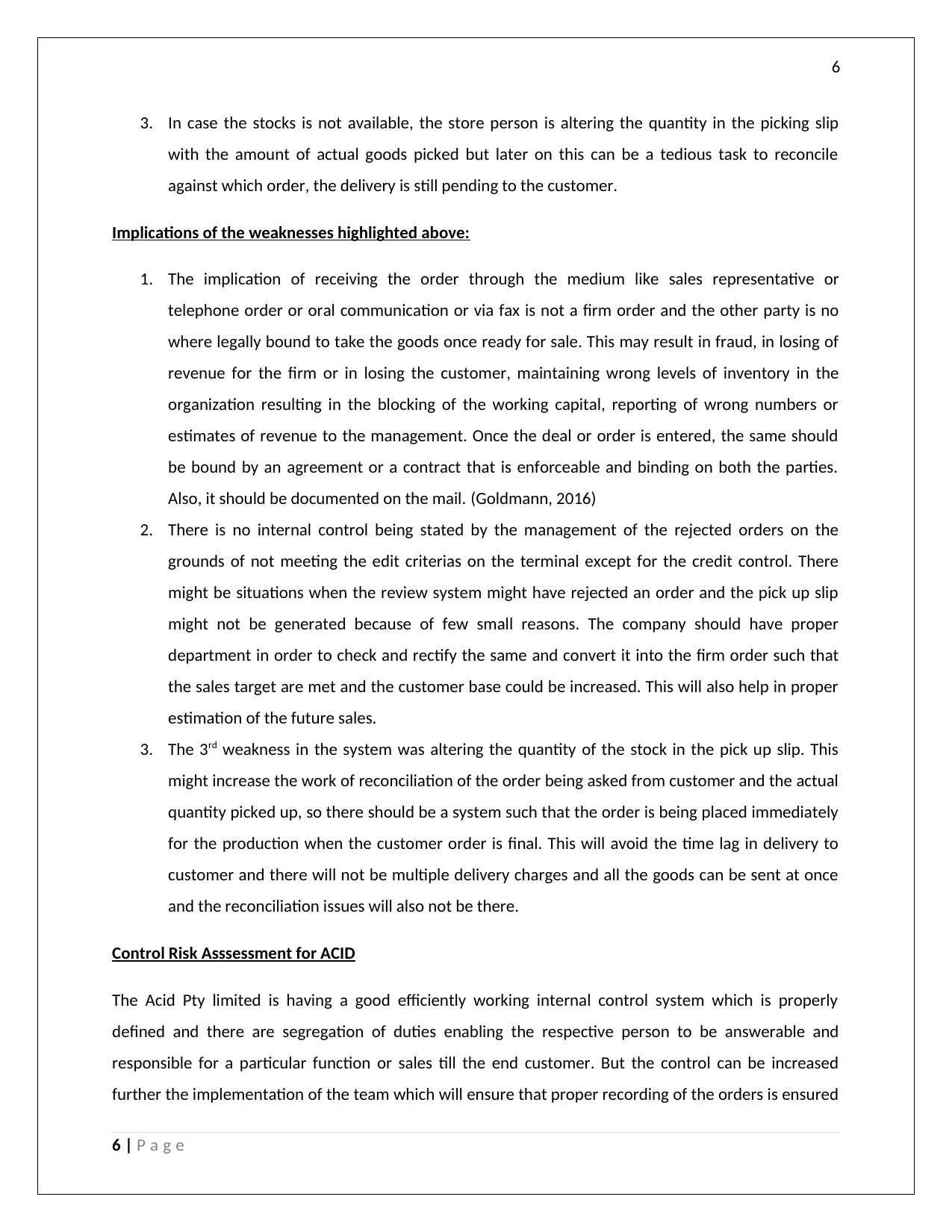
6
3. In case the stocks is not available, the store person is altering the quantity in the picking slip
with the amount of actual goods picked but later on this can be a tedious task to reconcile
against which order, the delivery is still pending to the customer.
Implications of the weaknesses highlighted above:
1. The implication of receiving the order through the medium like sales representative or
telephone order or oral communication or via fax is not a firm order and the other party is no
where legally bound to take the goods once ready for sale. This may result in fraud, in losing of
revenue for the firm or in losing the customer, maintaining wrong levels of inventory in the
organization resulting in the blocking of the working capital, reporting of wrong numbers or
estimates of revenue to the management. Once the deal or order is entered, the same should
be bound by an agreement or a contract that is enforceable and binding on both the parties.
Also, it should be documented on the mail. (Goldmann, 2016)
2. There is no internal control being stated by the management of the rejected orders on the
grounds of not meeting the edit criterias on the terminal except for the credit control. There
might be situations when the review system might have rejected an order and the pick up slip
might not be generated because of few small reasons. The company should have proper
department in order to check and rectify the same and convert it into the firm order such that
the sales target are met and the customer base could be increased. This will also help in proper
estimation of the future sales.
3. The 3rd weakness in the system was altering the quantity of the stock in the pick up slip. This
might increase the work of reconciliation of the order being asked from customer and the actual
quantity picked up, so there should be a system such that the order is being placed immediately
for the production when the customer order is final. This will avoid the time lag in delivery to
customer and there will not be multiple delivery charges and all the goods can be sent at once
and the reconciliation issues will also not be there.
Control Risk Asssessment for ACID
The Acid Pty limited is having a good efficiently working internal control system which is properly
defined and there are segregation of duties enabling the respective person to be answerable and
responsible for a particular function or sales till the end customer. But the control can be increased
further the implementation of the team which will ensure that proper recording of the orders is ensured
6 | P a g e
3. In case the stocks is not available, the store person is altering the quantity in the picking slip
with the amount of actual goods picked but later on this can be a tedious task to reconcile
against which order, the delivery is still pending to the customer.
Implications of the weaknesses highlighted above:
1. The implication of receiving the order through the medium like sales representative or
telephone order or oral communication or via fax is not a firm order and the other party is no
where legally bound to take the goods once ready for sale. This may result in fraud, in losing of
revenue for the firm or in losing the customer, maintaining wrong levels of inventory in the
organization resulting in the blocking of the working capital, reporting of wrong numbers or
estimates of revenue to the management. Once the deal or order is entered, the same should
be bound by an agreement or a contract that is enforceable and binding on both the parties.
Also, it should be documented on the mail. (Goldmann, 2016)
2. There is no internal control being stated by the management of the rejected orders on the
grounds of not meeting the edit criterias on the terminal except for the credit control. There
might be situations when the review system might have rejected an order and the pick up slip
might not be generated because of few small reasons. The company should have proper
department in order to check and rectify the same and convert it into the firm order such that
the sales target are met and the customer base could be increased. This will also help in proper
estimation of the future sales.
3. The 3rd weakness in the system was altering the quantity of the stock in the pick up slip. This
might increase the work of reconciliation of the order being asked from customer and the actual
quantity picked up, so there should be a system such that the order is being placed immediately
for the production when the customer order is final. This will avoid the time lag in delivery to
customer and there will not be multiple delivery charges and all the goods can be sent at once
and the reconciliation issues will also not be there.
Control Risk Asssessment for ACID
The Acid Pty limited is having a good efficiently working internal control system which is properly
defined and there are segregation of duties enabling the respective person to be answerable and
responsible for a particular function or sales till the end customer. But the control can be increased
further the implementation of the team which will ensure that proper recording of the orders is ensured
6 | P a g e
Paraphrase This Document
Need a fresh take? Get an instant paraphrase of this document with our AI Paraphraser
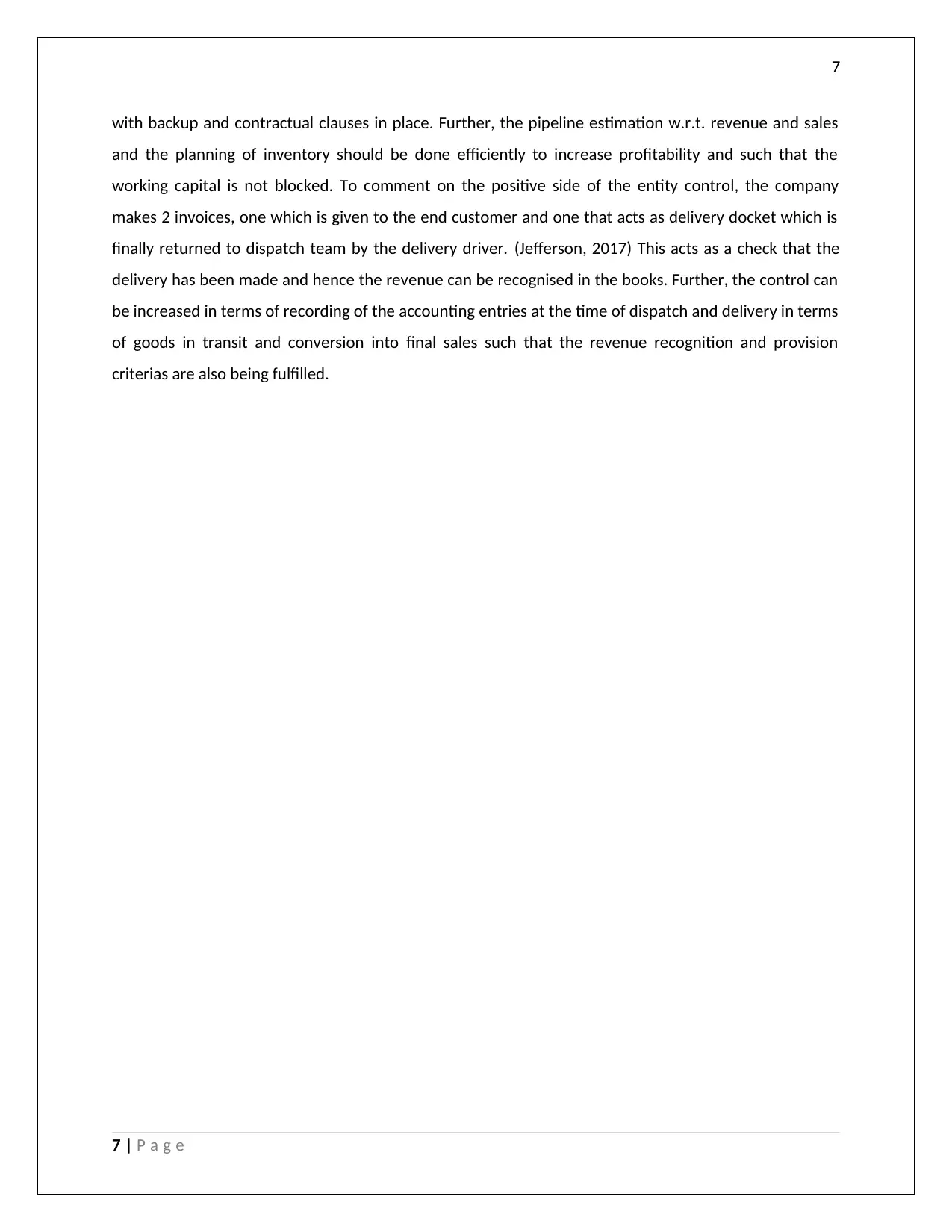
7
with backup and contractual clauses in place. Further, the pipeline estimation w.r.t. revenue and sales
and the planning of inventory should be done efficiently to increase profitability and such that the
working capital is not blocked. To comment on the positive side of the entity control, the company
makes 2 invoices, one which is given to the end customer and one that acts as delivery docket which is
finally returned to dispatch team by the delivery driver. (Jefferson, 2017) This acts as a check that the
delivery has been made and hence the revenue can be recognised in the books. Further, the control can
be increased in terms of recording of the accounting entries at the time of dispatch and delivery in terms
of goods in transit and conversion into final sales such that the revenue recognition and provision
criterias are also being fulfilled.
7 | P a g e
with backup and contractual clauses in place. Further, the pipeline estimation w.r.t. revenue and sales
and the planning of inventory should be done efficiently to increase profitability and such that the
working capital is not blocked. To comment on the positive side of the entity control, the company
makes 2 invoices, one which is given to the end customer and one that acts as delivery docket which is
finally returned to dispatch team by the delivery driver. (Jefferson, 2017) This acts as a check that the
delivery has been made and hence the revenue can be recognised in the books. Further, the control can
be increased in terms of recording of the accounting entries at the time of dispatch and delivery in terms
of goods in transit and conversion into final sales such that the revenue recognition and provision
criterias are also being fulfilled.
7 | P a g e
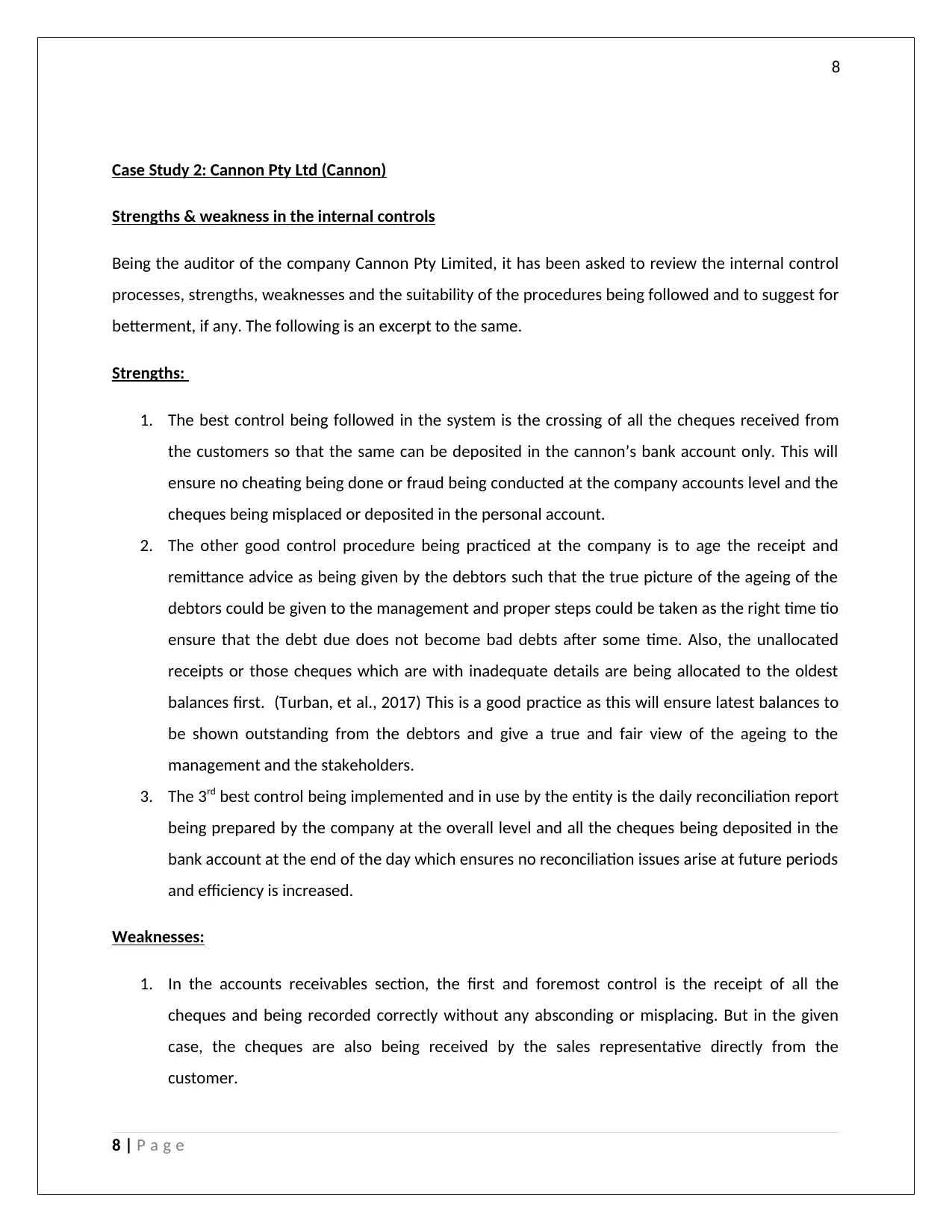
8
Case Study 2: Cannon Pty Ltd (Cannon)
Strengths & weakness in the internal controls
Being the auditor of the company Cannon Pty Limited, it has been asked to review the internal control
processes, strengths, weaknesses and the suitability of the procedures being followed and to suggest for
betterment, if any. The following is an excerpt to the same.
Strengths:
1. The best control being followed in the system is the crossing of all the cheques received from
the customers so that the same can be deposited in the cannon’s bank account only. This will
ensure no cheating being done or fraud being conducted at the company accounts level and the
cheques being misplaced or deposited in the personal account.
2. The other good control procedure being practiced at the company is to age the receipt and
remittance advice as being given by the debtors such that the true picture of the ageing of the
debtors could be given to the management and proper steps could be taken as the right time tio
ensure that the debt due does not become bad debts after some time. Also, the unallocated
receipts or those cheques which are with inadequate details are being allocated to the oldest
balances first. (Turban, et al., 2017) This is a good practice as this will ensure latest balances to
be shown outstanding from the debtors and give a true and fair view of the ageing to the
management and the stakeholders.
3. The 3rd best control being implemented and in use by the entity is the daily reconciliation report
being prepared by the company at the overall level and all the cheques being deposited in the
bank account at the end of the day which ensures no reconciliation issues arise at future periods
and efficiency is increased.
Weaknesses:
1. In the accounts receivables section, the first and foremost control is the receipt of all the
cheques and being recorded correctly without any absconding or misplacing. But in the given
case, the cheques are also being received by the sales representative directly from the
customer.
8 | P a g e
Case Study 2: Cannon Pty Ltd (Cannon)
Strengths & weakness in the internal controls
Being the auditor of the company Cannon Pty Limited, it has been asked to review the internal control
processes, strengths, weaknesses and the suitability of the procedures being followed and to suggest for
betterment, if any. The following is an excerpt to the same.
Strengths:
1. The best control being followed in the system is the crossing of all the cheques received from
the customers so that the same can be deposited in the cannon’s bank account only. This will
ensure no cheating being done or fraud being conducted at the company accounts level and the
cheques being misplaced or deposited in the personal account.
2. The other good control procedure being practiced at the company is to age the receipt and
remittance advice as being given by the debtors such that the true picture of the ageing of the
debtors could be given to the management and proper steps could be taken as the right time tio
ensure that the debt due does not become bad debts after some time. Also, the unallocated
receipts or those cheques which are with inadequate details are being allocated to the oldest
balances first. (Turban, et al., 2017) This is a good practice as this will ensure latest balances to
be shown outstanding from the debtors and give a true and fair view of the ageing to the
management and the stakeholders.
3. The 3rd best control being implemented and in use by the entity is the daily reconciliation report
being prepared by the company at the overall level and all the cheques being deposited in the
bank account at the end of the day which ensures no reconciliation issues arise at future periods
and efficiency is increased.
Weaknesses:
1. In the accounts receivables section, the first and foremost control is the receipt of all the
cheques and being recorded correctly without any absconding or misplacing. But in the given
case, the cheques are also being received by the sales representative directly from the
customer.
8 | P a g e
⊘ This is a preview!⊘
Do you want full access?
Subscribe today to unlock all pages.

Trusted by 1+ million students worldwide
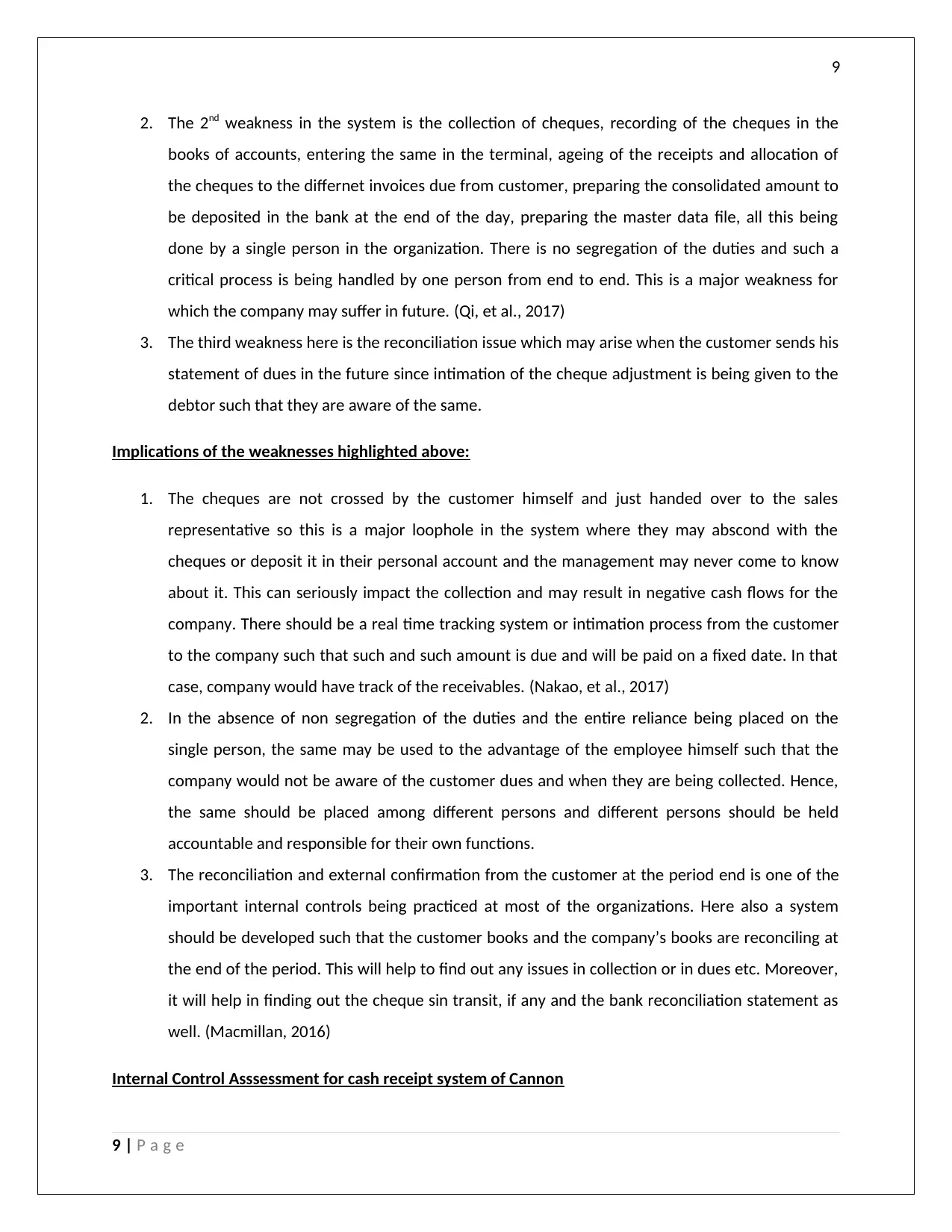
9
2. The 2nd weakness in the system is the collection of cheques, recording of the cheques in the
books of accounts, entering the same in the terminal, ageing of the receipts and allocation of
the cheques to the differnet invoices due from customer, preparing the consolidated amount to
be deposited in the bank at the end of the day, preparing the master data file, all this being
done by a single person in the organization. There is no segregation of the duties and such a
critical process is being handled by one person from end to end. This is a major weakness for
which the company may suffer in future. (Qi, et al., 2017)
3. The third weakness here is the reconciliation issue which may arise when the customer sends his
statement of dues in the future since intimation of the cheque adjustment is being given to the
debtor such that they are aware of the same.
Implications of the weaknesses highlighted above:
1. The cheques are not crossed by the customer himself and just handed over to the sales
representative so this is a major loophole in the system where they may abscond with the
cheques or deposit it in their personal account and the management may never come to know
about it. This can seriously impact the collection and may result in negative cash flows for the
company. There should be a real time tracking system or intimation process from the customer
to the company such that such and such amount is due and will be paid on a fixed date. In that
case, company would have track of the receivables. (Nakao, et al., 2017)
2. In the absence of non segregation of the duties and the entire reliance being placed on the
single person, the same may be used to the advantage of the employee himself such that the
company would not be aware of the customer dues and when they are being collected. Hence,
the same should be placed among different persons and different persons should be held
accountable and responsible for their own functions.
3. The reconciliation and external confirmation from the customer at the period end is one of the
important internal controls being practiced at most of the organizations. Here also a system
should be developed such that the customer books and the company’s books are reconciling at
the end of the period. This will help to find out any issues in collection or in dues etc. Moreover,
it will help in finding out the cheque sin transit, if any and the bank reconciliation statement as
well. (Macmillan, 2016)
Internal Control Asssessment for cash receipt system of Cannon
9 | P a g e
2. The 2nd weakness in the system is the collection of cheques, recording of the cheques in the
books of accounts, entering the same in the terminal, ageing of the receipts and allocation of
the cheques to the differnet invoices due from customer, preparing the consolidated amount to
be deposited in the bank at the end of the day, preparing the master data file, all this being
done by a single person in the organization. There is no segregation of the duties and such a
critical process is being handled by one person from end to end. This is a major weakness for
which the company may suffer in future. (Qi, et al., 2017)
3. The third weakness here is the reconciliation issue which may arise when the customer sends his
statement of dues in the future since intimation of the cheque adjustment is being given to the
debtor such that they are aware of the same.
Implications of the weaknesses highlighted above:
1. The cheques are not crossed by the customer himself and just handed over to the sales
representative so this is a major loophole in the system where they may abscond with the
cheques or deposit it in their personal account and the management may never come to know
about it. This can seriously impact the collection and may result in negative cash flows for the
company. There should be a real time tracking system or intimation process from the customer
to the company such that such and such amount is due and will be paid on a fixed date. In that
case, company would have track of the receivables. (Nakao, et al., 2017)
2. In the absence of non segregation of the duties and the entire reliance being placed on the
single person, the same may be used to the advantage of the employee himself such that the
company would not be aware of the customer dues and when they are being collected. Hence,
the same should be placed among different persons and different persons should be held
accountable and responsible for their own functions.
3. The reconciliation and external confirmation from the customer at the period end is one of the
important internal controls being practiced at most of the organizations. Here also a system
should be developed such that the customer books and the company’s books are reconciling at
the end of the period. This will help to find out any issues in collection or in dues etc. Moreover,
it will help in finding out the cheque sin transit, if any and the bank reconciliation statement as
well. (Macmillan, 2016)
Internal Control Asssessment for cash receipt system of Cannon
9 | P a g e
Paraphrase This Document
Need a fresh take? Get an instant paraphrase of this document with our AI Paraphraser
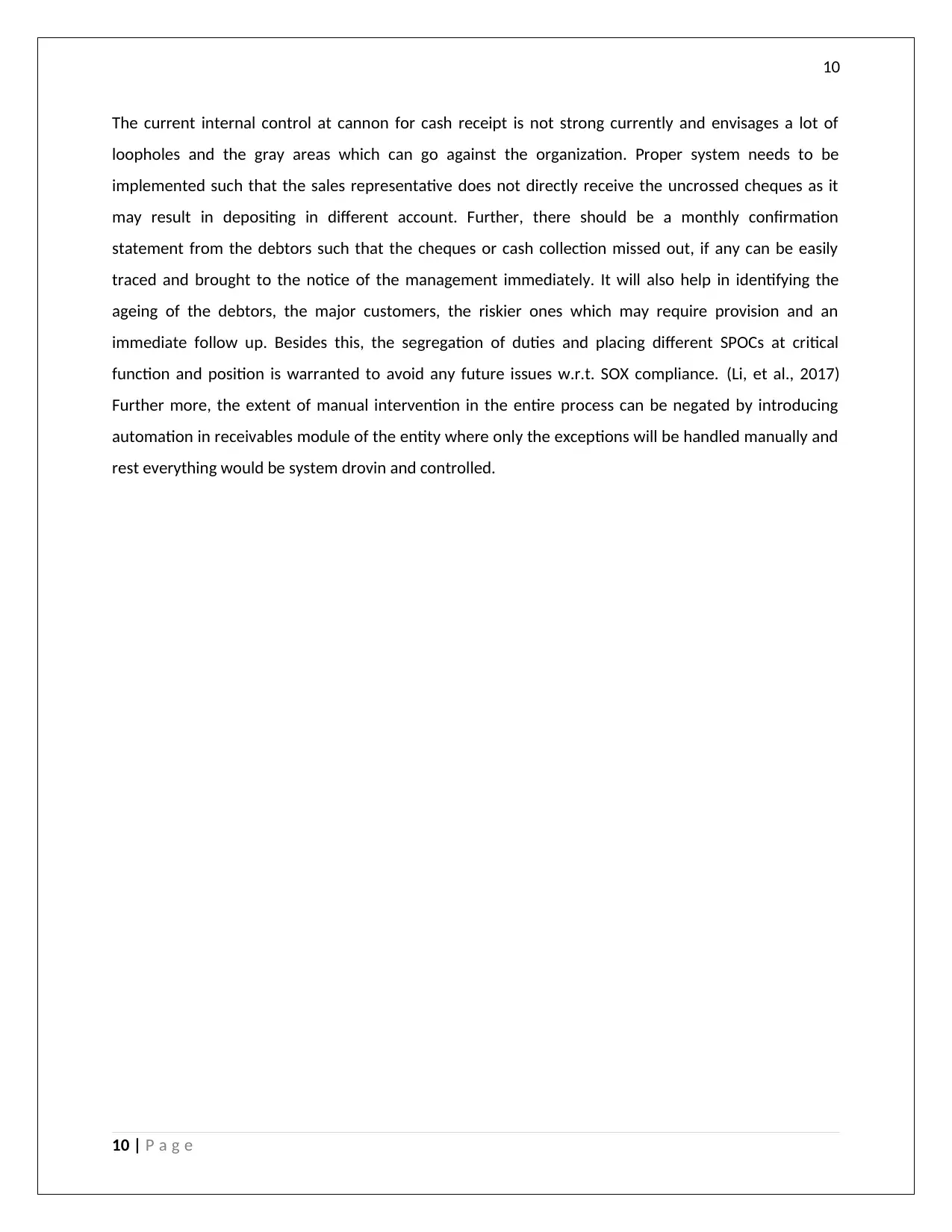
10
The current internal control at cannon for cash receipt is not strong currently and envisages a lot of
loopholes and the gray areas which can go against the organization. Proper system needs to be
implemented such that the sales representative does not directly receive the uncrossed cheques as it
may result in depositing in different account. Further, there should be a monthly confirmation
statement from the debtors such that the cheques or cash collection missed out, if any can be easily
traced and brought to the notice of the management immediately. It will also help in identifying the
ageing of the debtors, the major customers, the riskier ones which may require provision and an
immediate follow up. Besides this, the segregation of duties and placing different SPOCs at critical
function and position is warranted to avoid any future issues w.r.t. SOX compliance. (Li, et al., 2017)
Further more, the extent of manual intervention in the entire process can be negated by introducing
automation in receivables module of the entity where only the exceptions will be handled manually and
rest everything would be system drovin and controlled.
10 | P a g e
The current internal control at cannon for cash receipt is not strong currently and envisages a lot of
loopholes and the gray areas which can go against the organization. Proper system needs to be
implemented such that the sales representative does not directly receive the uncrossed cheques as it
may result in depositing in different account. Further, there should be a monthly confirmation
statement from the debtors such that the cheques or cash collection missed out, if any can be easily
traced and brought to the notice of the management immediately. It will also help in identifying the
ageing of the debtors, the major customers, the riskier ones which may require provision and an
immediate follow up. Besides this, the segregation of duties and placing different SPOCs at critical
function and position is warranted to avoid any future issues w.r.t. SOX compliance. (Li, et al., 2017)
Further more, the extent of manual intervention in the entire process can be negated by introducing
automation in receivables module of the entity where only the exceptions will be handled manually and
rest everything would be system drovin and controlled.
10 | P a g e
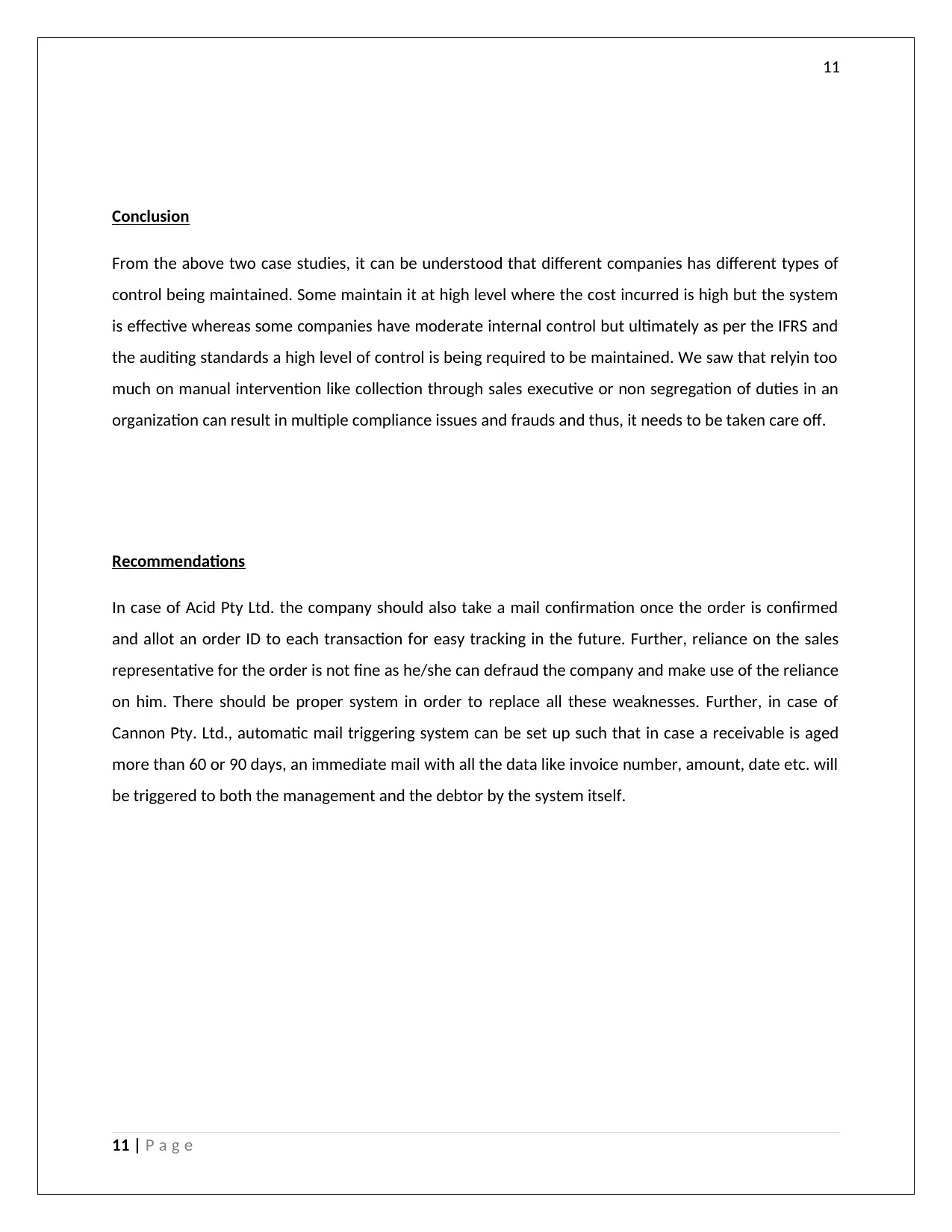
11
Conclusion
From the above two case studies, it can be understood that different companies has different types of
control being maintained. Some maintain it at high level where the cost incurred is high but the system
is effective whereas some companies have moderate internal control but ultimately as per the IFRS and
the auditing standards a high level of control is being required to be maintained. We saw that relyin too
much on manual intervention like collection through sales executive or non segregation of duties in an
organization can result in multiple compliance issues and frauds and thus, it needs to be taken care off.
Recommendations
In case of Acid Pty Ltd. the company should also take a mail confirmation once the order is confirmed
and allot an order ID to each transaction for easy tracking in the future. Further, reliance on the sales
representative for the order is not fine as he/she can defraud the company and make use of the reliance
on him. There should be proper system in order to replace all these weaknesses. Further, in case of
Cannon Pty. Ltd., automatic mail triggering system can be set up such that in case a receivable is aged
more than 60 or 90 days, an immediate mail with all the data like invoice number, amount, date etc. will
be triggered to both the management and the debtor by the system itself.
11 | P a g e
Conclusion
From the above two case studies, it can be understood that different companies has different types of
control being maintained. Some maintain it at high level where the cost incurred is high but the system
is effective whereas some companies have moderate internal control but ultimately as per the IFRS and
the auditing standards a high level of control is being required to be maintained. We saw that relyin too
much on manual intervention like collection through sales executive or non segregation of duties in an
organization can result in multiple compliance issues and frauds and thus, it needs to be taken care off.
Recommendations
In case of Acid Pty Ltd. the company should also take a mail confirmation once the order is confirmed
and allot an order ID to each transaction for easy tracking in the future. Further, reliance on the sales
representative for the order is not fine as he/she can defraud the company and make use of the reliance
on him. There should be proper system in order to replace all these weaknesses. Further, in case of
Cannon Pty. Ltd., automatic mail triggering system can be set up such that in case a receivable is aged
more than 60 or 90 days, an immediate mail with all the data like invoice number, amount, date etc. will
be triggered to both the management and the debtor by the system itself.
11 | P a g e
⊘ This is a preview!⊘
Do you want full access?
Subscribe today to unlock all pages.

Trusted by 1+ million students worldwide
1 out of 13
Related Documents
Your All-in-One AI-Powered Toolkit for Academic Success.
+13062052269
info@desklib.com
Available 24*7 on WhatsApp / Email
![[object Object]](/_next/static/media/star-bottom.7253800d.svg)
Unlock your academic potential
Copyright © 2020–2025 A2Z Services. All Rights Reserved. Developed and managed by ZUCOL.





